On a Saturday evening in 2015, I found myself in a white-out blizzard, driving up steep and curvy West Virginia back roads. Normally, I would have admitted defeat and turned back. But I kept going, propelled up the mountain by thoughts of the unique Mardi Gras foods and festivities that awaited me in an improbable-seeming Swiss village at top.
Helvetia, population 59, is an incongruous place — an Alpine village nestled in the isolated wilderness of West Virginia. It was settled in 1869 by Swiss craftsmen drawn by the large tracts of cheap land, beautiful mountains and plentiful forests of game. The town is situated along the Buckhannon River in a high mountain valley, and as I was reminded on my drive, is not very easy to get to.
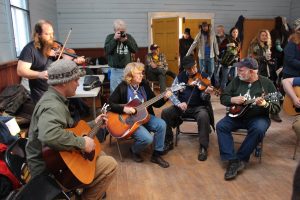
Owing to both this seclusion and the continuous preservation efforts of determined locals, Helvetia has retained much of its Swiss character and traditions over the years. Witness the historic and charming Alpine-style buildings — some of which date to the town’s founding. There are the Cheese Haus and Beekeeper Inn, and the town’s only restaurant — The Hutte (pronounced HOO-tay) — which serves traditional Swiss-German fare. And the celebration of this heritage culminates in the yearly pre-Lenten festival, Fasnacht.
At one time, Fasnacht was a quiet event marked in the private homes of Helvetia. But in the late 1960s, Eleanor Mailloux, co-founder of the Hutte, restored the holiday as a public celebration — and a lure to attract wintertime tourists to the secluded town. Her vision: an event that combined the traditional Swiss pre-Lenten festivities of Fasnacht (meaning “the night before the fast”) with the Swiss rite of spring holiday, Sechseläuten — all carried out with a homemade Helvetia flair.
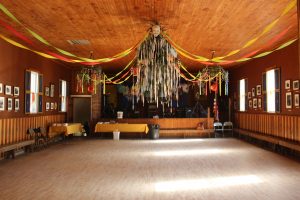
The party begins with a Swiss feast at the Hutte. Festivalgoers — both locals and dozens, if not hundreds of tourists — then proceed in a masked, lamp-lit parade from one of the town’s community dance halls to the other. (Helvetia may be short on people, but never on dancing.) Then the square dance begins, with a handmade, stuffed effigy of Old Man Winter looming over the dance floor. At the stroke of midnight, he’s hoisted from the rafters and thrown on the awaiting bonfire to the jeers and songs of the revelers.
The dancing and firelight may add to the magic of Fasnacht, but it’s the hearty Swiss food that serves as the festival centerpiece. Town historian Eleanor Betler, who has lived in Helvetia for 54 years, says, “Food is a very important part of any Helvetia event, because when you come at least an hour from any large town, you want food! It’s what really brings people here.”
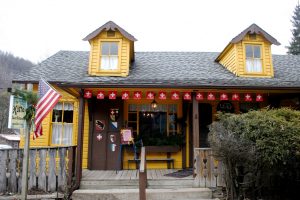
The Hutte, housed in an Alpine chalet painted bright gold and adorned with Swiss flags and hand-printed coats of arms, is situated, like a beacon to the village, at the town’s only intersection. For Fasnacht, the restaurant serves a special “best of” sampler plate — itself a blend of Swiss and Appalachian culinary traditions, with some uniquely Hutte creations mixed in.
There are veal and pork bratwurst, homemade sausage, sauerkraut, parsley potatoes, green beans cooked in pork fat, peach cobbler and homemade bread with baby Swiss cheese. And then there are the quirky dishes like curried chicken and clove-pickled pineapple — legacies of Hutte founder Eleanor Mailloux’s travels in the East. It’s washed down with ice cold local beer (made by Mailloux’s grandson, who co-owns Mountain State Brewing Co. in Morgantown) served in frosted ceramic beer steins.
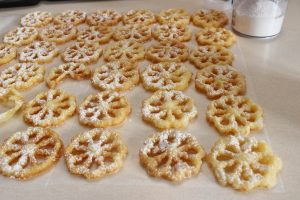
But no pre-Lenten celebration would be complete without the fatty indulgence of fried dough. In Helvetia of yore, residents would fast and refrain from even their monthly square dances during Lent, so Fasnacht was a time to partake in rich foods of all kinds, particularly doughnuts. Eleanor Betler makes two of the traditional versions served at the Fasnacht square dance — rosettes and hozablatz. Rosettes are flower-shaped fried doughnuts or cookies, made with a special iron and fried until extremely light and crispy. (Her grandmother advised a nip of bourbon for extra crispness.)
Hozablatz, or “knee patches,” are similarly crunchy, but thin and rectangular. “Ladies would have a big white apron and they would roll this dough out and press them over their knee to make them real thin,” says Betler. “They said it should be thin enough to be able to read a newspaper through it.” Once fried, they’re covered with sugar and served.
The confections are traditionally Swiss, but much like the food served at the Hutte, have taken on their
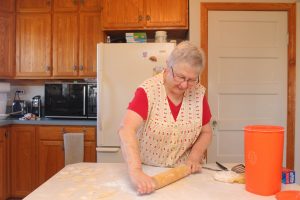
own Helvetia flavor over the years. Betler relates, laughing, “Years ago I asked this old lady, ‘When you make your rosettes you put granulated sugar on it. But my grandmother always used powdered sugar. What’s the difference?’ And she said, ‘Well, you use what you have!’ ” Being so far away from a supermarket, cooks in Helvetia have learned to improvise.
That mentality remains pervasive throughout Helvetia, where everyone knows the best masks and doughnuts are homemade, the best signs are hand-painted, and snowstorms in below-freezing temperatures can’t snuff out the warmth of Fasnacht.
Hozablatz
From Oppis Guet’s Vo Helvetia (Something Good From Helvetia)
9 eggs
1 cup medium cream
1 small teaspoon salt
Enough flour to make a stiff dough
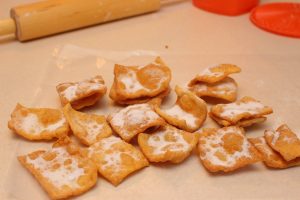
Roll out very thin. The old people say that the dough should be rolled so thin that you can read a newspaper through it. In the olden days the women had a special apron they spread over their knee for making hozablatz (knee patches). They would pull a small piece of dough into a very thin patch. The patches should be cut to be about 6 or 8 inches in diameter. Heat some lard in a skillet or dutch oven for deep frying the patches. The lard should be hot enough for fast frying. When golden, turn and brown on other side. Remove and sprinkle with sugar.
Emily Hilliard is the West Virginia state folklorist. Find more of her work at emilyehilliard.com.
A version of this story was first published by NPR’s The Salt in 2015.



